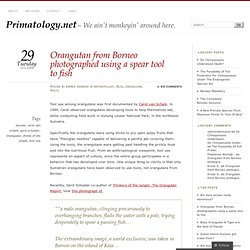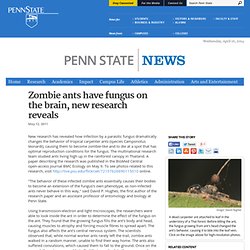

"Immortal" Jellyfish. While it is often joked that cats have nine lives, a certain species of jellyfish has been deemed “immortal” by scientists who have observed its ability to, when in crisis, revert its cells to their earliest form and grow anew.

That means that these tiny creatures, 4 mm to 5 mm long, potentially have infinite lives. The creature, known scientifically as Turritopsis nutricula, was discovered in the Mediterranean Sea in 1883, but its unique regeneration was not known until the mid-1990s. How does the process work? If a mature Turritopsis is threatened — injured or starving, for example — it attaches itself to a surface in warm ocean waters and converts into a blob. From that state, its cells undergo transdifferentiation, in which the cells essentially transform into different types of cells. But Turritopsis can — and do — die. Orangutan Spear Fishing. Tool use among orangutans was first documented by Carel van Schaik.

In 1994, Carel observed orangutans developing tools to help themselves eat, while conducting field work in Gunung Leuser National Park, in the northwest Sumatra. Specifically the orangutans were using sticks to pry open pulpy fruits that have “Plexiglas needles” capable of delivering a painful jab covering them. Using the tools, the orangutans were getting past handling the prickly husk and into the nutritious fruit. From an anthropological viewpoint, tool use represents an aspect of culture, since the entire group participates in a behavior that has developed over time. One unique thing to clarify is that only Sumatran orangutans have been observed to use tools, not orangutans from Borneo. Recently, Gerd Schuster co-author of Thinkers of the Jungle: The Orangutan Report, took this photograph of, Pretty awesome image, no?
Schaik, C.P., Fox, E.A., Sitompul, A.F. (1996). Like this: Like Loading... Zombie Ants. New research has revealed how infection by a parasitic fungus dramatically changes the behavior of tropical carpenter ants (species Camponotus leonardi), causing them to become zombie-like and to die at a spot that has optimal reproduction conditions for the fungus.

The multinational research team studied ants living high up in the rainforest canopy in Thailand. A paper describing the research was published in the BioMed Central open-access journal BMC Ecology on May 9. To see photos related to this research, visit online. "The behavior of these infected zombie ants essentially causes their bodies to become an extension of the fungus's own phenotype, as non-infected ants never behave in this way," said David P. Hughes, the first author of the research paper and an assistant professor of entomology and biology at Penn State. Using transmission-electron and light microscopes, the researchers were able to look inside the ant in order to determine the effect of the fungus on the ant. Intelligence in Corvids. Betty the crow bends some wire into a hook to retrieve a treat-laden bucket from a well (footage: behavioural ecology group, Oxford University) "In the past, people thought birds were stupid," laments the aptly named scientist Christopher Bird.

But in fact, some of our feathered friends are far cleverer than we might think. And one group in particular - the corvids - has astonished scientists with extraordinary feats of memory, an ability to employ complex social reasoning and, perhaps most strikingly, a remarkable aptitude for crafting and using tools. Mr Bird, who is based at the department of zoology at Cambridge University and is supervised by Dr Nathan Emery, says: "I would rate corvids as being as intelligent as primates in many ways.
" The corvids - a group that includes crows, ravens, rooks, jackdaws, jays and magpies - contain some of the most social species of birds. "Sometimes, if they are being watched, then they'll even go back and hide the food again. " You looking at me?